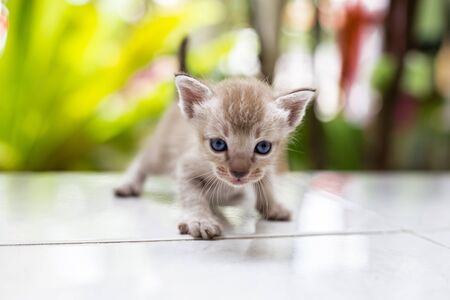1. Creating an Engaging Environment
Keeping your indoor cat active and mentally stimulated starts with creating a home that sparks their curiosity and encourages natural behaviors like climbing, hiding, and exploring. Cats love to investigate new spaces, so adding cat-friendly furniture and features can make a big difference in their happiness and health.
Cat-Friendly Furniture Ideas
Investing in the right furniture helps your cat stay busy throughout the day. Here are some popular options:
| Furniture Type | Benefits | Where to Place |
|---|---|---|
| Cat Trees & Towers | Great for climbing, scratching, and perching | Near windows or in living rooms |
| Wall Shelves & Perches | Adds vertical space for jumping and exploring | Along empty walls or above furniture |
| Window Hammocks & Beds | Provides cozy spots to nap and birdwatch | On sunny window sills |
| Tunnels & Hideouts | Makes playtime fun and offers hiding places for shy cats | In quiet corners or under tables |
| Interactive Play Mats | Encourages hunting instincts with textures and toys | Anywhere on the floor with enough space |
Shelves and Climbing Spaces
Cats naturally love to climb. Installing shelves at different heights gives your feline friend new perspectives to explore. Try arranging a few sturdy shelves like steps up your wall, leading to a high perch or lookout spot. This not only entertains them but also gives them a sense of safety.
Tip:
If you rent your home, look for freestanding cat trees or modular shelf systems that don’t require drilling holes in the wall.
Cozy Hiding Spots
Cats feel secure when they have private spaces to retreat to. You can create cozy hideaways by placing covered beds, cardboard boxes, or fabric tunnels around your home. Rotate these spots every few weeks to keep things interesting for your kitty.
Quick DIY Ideas:
- Line a cardboard box with a soft blanket for an instant hideout.
- Drape a towel over a chair to create a tent-like nook.
- Use old suitcases or baskets as quirky cat beds.
By making simple changes to your home environment, you’ll help your indoor cat stay active, curious, and happy every day!
Interactive Playtime Routines
Why Interactive Play is Important for Indoor Cats
Cats are natural hunters, and even if they live indoors, they still need to chase, pounce, and play. Regular playtime helps your cat burn off energy, prevent boredom, and stay mentally sharp. Engaging play sessions can also help curb unwanted behaviors like scratching furniture or nighttime zoomies.
Recommended Toys for Active Play
| Toy Type | How It Helps | Tips for Use |
|---|---|---|
| Wand Toys (like feather wands) | Mimics prey movement to trigger hunting instincts | Move the wand in unpredictable patterns; let your cat “catch” it sometimes |
| Laser Pointers | Encourages running and jumping for a full-body workout | Avoid shining directly into eyes; end with a physical toy your cat can catch |
| Feather Teasers | Stimulates chasing and pouncing behaviors | Dangle at different heights or drag along the floor to keep things interesting |
Suggestions for Daily Play Sessions
- Set aside 10-15 minutes: Try to have at least two play sessions every day, morning and evening work best for most cats.
- Mix up the toys: Rotate between wand toys, laser pointers, and feather teasers to keep your cat interested and challenged.
- Create mini-hunting games: Hide toys under blankets or behind furniture to mimic hiding prey and encourage stalking behavior.
- Let them win: Allow your cat to catch the toy now and then so they feel successful and satisfied.
- Use treats as rewards: For extra motivation, reward your cat with a treat after a play session or when they “capture” their toy.
Sample Weekly Play Routine
| Day of Week | Main Toy Used | Playtime Tip |
|---|---|---|
| Monday | Feather Wand | Swoop above and around furniture for leaping fun |
| Tuesday | Laser Pointer | Create zig-zag patterns across open spaces to encourage running |
| Wednesday | Feather Teaser | Hide behind pillows or under rugs for surprise attacks |
| Thursday | Wand Toy with Bell | Add sound stimulation by shaking before moving the toy around corners |
| Friday | Laser Pointer & Plush Mouse Combo | Finish laser play by tossing a plush mouse for your cat to “catch” physically |
| Saturday & Sunday | Your Cat’s Favorite Toy(s) | Let your cat choose what excites them most—observe their preferences! |
![]()
3. DIY Enrichment and Puzzle Feeders
How to Introduce Puzzle Feeders to Your Cat
Puzzle feeders are a fantastic way to keep your indoor cat both physically active and mentally sharp. These devices make your cat work for their food or treats, engaging their natural hunting instincts. If your cat has never used a puzzle feeder before, start simple—sprinkle a few treats around the feeder so they get interested, then gradually increase the challenge as they learn how it works.
Types of Puzzle Feeders and Treat-Dispensing Toys
| Type | Description | Benefits |
|---|---|---|
| Rolling Treat Balls | Balls that dispense treats as they roll across the floor. | Encourage chasing and batting; provides exercise. |
| Food Maze Bowls | Bowls with built-in obstacles that cats must navigate to reach food. | Slows down eating; promotes problem-solving skills. |
| Tower Puzzles | Treats placed inside towers with multiple openings. | Stimulates curiosity; offers varied difficulty levels. |
| Homemade Challenges | DIY puzzles using cardboard boxes, toilet paper rolls, or egg cartons filled with kibble or treats. | Budget-friendly; customizable based on your cat’s skill level. |
Easy Homemade Enrichment Ideas
- Cardboard Box Hide-and-Seek: Cut holes in a cardboard box and drop in some treats or toys for your cat to fish out.
- Muffin Tin Game: Place treats in a muffin tin and cover some with tennis balls for your cat to uncover.
- Paper Bag Exploration: Drop a couple of crunchy treats inside a paper bag to spark curiosity and playfulness (always supervise for safety).
Tips for Success When Introducing New Enrichment Activities
- Start slow with easy puzzles and reward your cat’s efforts with praise or extra treats.
- If your cat seems frustrated, show them how it works by gently moving the toy or helping them find a treat.
- Rotate different feeders and toys to keep things interesting and prevent boredom.
- Avoid overfeeding—adjust meal portions if using treats or kibble in enrichment activities.
4. Incorporating Safe Outdoor Experiences
Even though your cat lives indoors, safe exposure to the outdoors can do wonders for their physical and mental health. Let’s look at some popular and secure ways to let your cat enjoy the outside world without the risks that come with roaming free.
Catios: The Ultimate Outdoor Playpen
A “catio” (cat patio) is an enclosed outdoor space designed just for cats. Catios come in all shapes and sizes, from small window boxes to spacious backyard structures. They allow your cat to experience fresh air, sunshine, and exciting sights safely.
| Benefits of Catios | Ideas for Enrichment |
|---|---|
| Prevents escape and protects from dangers like cars or predators | Add climbing shelves, scratching posts, and plants that are safe for cats |
| Lets your cat watch birds, bugs, and squirrels up close | Rotate toys or hide treats to keep things interesting |
| Reduces boredom and stress | Include cozy resting spots for sunbathing or napping |
Leash Training Your Cat
Some indoor cats love going for walks! With patience, you can train your cat to wear a harness and walk on a leash. Start slow by letting your cat get used to the harness indoors before venturing outside. Always supervise your cat closely during walks, and choose quiet areas away from busy streets and dogs.
Tips for Successful Leash Training:
- Choose a harness made specifically for cats (not dogs)
- Reward your cat with treats and praise as they get comfortable wearing it
- Practice short sessions inside before exploring the yard or garden
- Let your cat set the pace—some cats prefer sniffing around rather than walking far
Window Perches: A Room with a View
If building a catio or leash training isn’t possible, window perches are a fantastic way to bring the outdoors in. Install a sturdy perch or hammock on a favorite window so your cat can safely watch birds, people, and passing cars. For extra fun, add a bird feeder outside the window (but out of reach) to attract wildlife.
Choosing the Right Window Perch:
- Make sure it supports your cat’s weight securely
- Place soft blankets or mats on top for comfort
- Select a window with lots of natural light but not too drafty or hot in summer
Giving your indoor cat safe outdoor experiences keeps them curious, active, and happy—all while protecting them from harm.
5. Rotating Toys and Novelty Games
Keeping your indoor cat entertained isn’t just about having a lot of toys—it’s about keeping things fresh and interesting. Just like people, cats can get bored with the same old routine. Swapping out toys regularly and introducing new games can make a big difference in keeping your kitty active and mentally engaged.
Why Rotation Matters
Cats are naturally curious animals, but if they see the same toys every day, those items quickly lose their appeal. By rotating toys, you keep things exciting for your cat. Try putting some toys away for a week or two, then bring them back out while storing others. This makes old toys feel brand new again!
Benefits of Toy Rotation
| Benefit | Description |
|---|---|
| Prevents Boredom | New or “forgotten” toys recapture your cat’s interest. |
| Encourages Activity | Unexpected toys encourage playful behavior and exercise. |
| Mental Stimulation | Your cat has to figure out how each toy works all over again. |
| Reduces Destructive Behavior | Bored cats sometimes chew or scratch furniture; rotating toys helps redirect that energy. |
Adding Novelty Games
Besides switching up toys, try introducing novelty games to keep things interesting. Puzzle feeders, treat-dispensing balls, or homemade obstacle courses challenge your cat’s brain and body. Even simple activities like hiding treats around the house or teaching your cat to “hunt” for their food can spark excitement and mental engagement.
Easy Game Ideas for Indoor Cats
| Game Type | Description |
|---|---|
| Puzzle Feeders | Fill with kibble or treats—your cat has to figure out how to get the reward. |
| Interactive Wand Toys | Mimic prey movements to encourage chasing and pouncing. |
| Treat Hide-and-Seek | Hide small treats around the room for your cat to sniff out and find. |
| Homemade Tunnels/Boxes | Create tunnels or mazes from boxes for exploring and playing hide-and-seek. |
Pro Tip: Get the Family Involved!
If you have kids at home, let them help pick out which toys to rotate or come up with new games. This not only keeps your cat happy but also makes playtime fun for everyone in the family!


